
Written by:
Matas Kibildis
Head of Growth @ aiclicks.io
Reviewed by:
Rokas Stankevicius
Founder @ aiclicks.io
If you’re reading this, you already know that search is changing fast. At AIclicks.io, I’ve watched the transition from keyword-based SEO to AI-powered semantic search reshape how brands get discovered online.
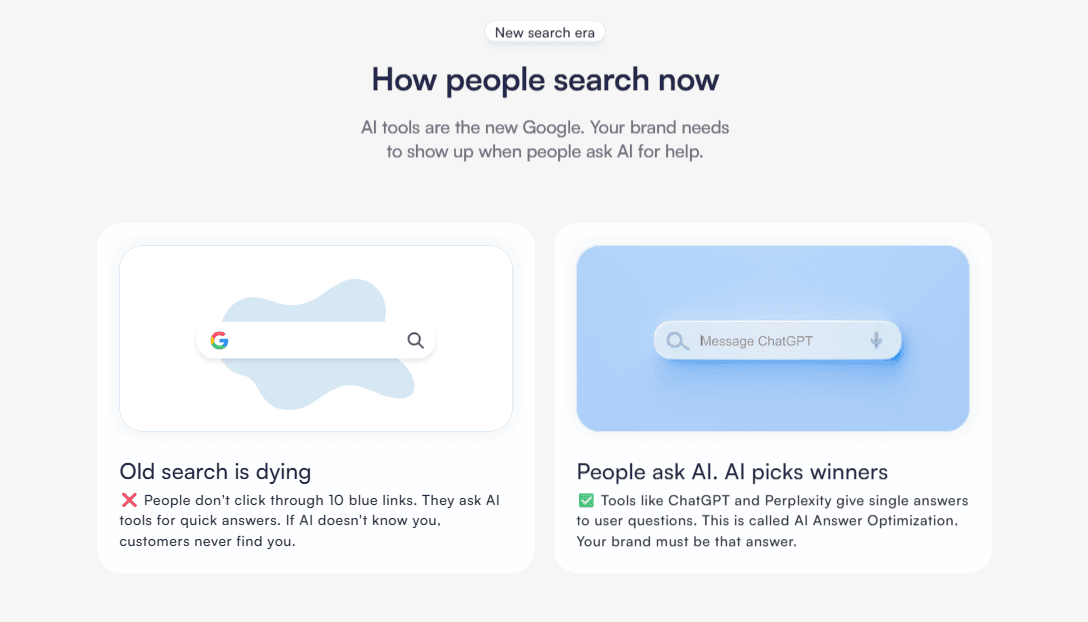
Right now, Perplexity AI stands out as one of the most trusted conversational search platforms in 2025, and its ranking system couldn’t be more different from the old rules.
Chasing keywords is no longer enough. To appear on Perplexity AI search results, you need to think deeply about semantic clarity, topical authority, factual trust, and technical accessibility.
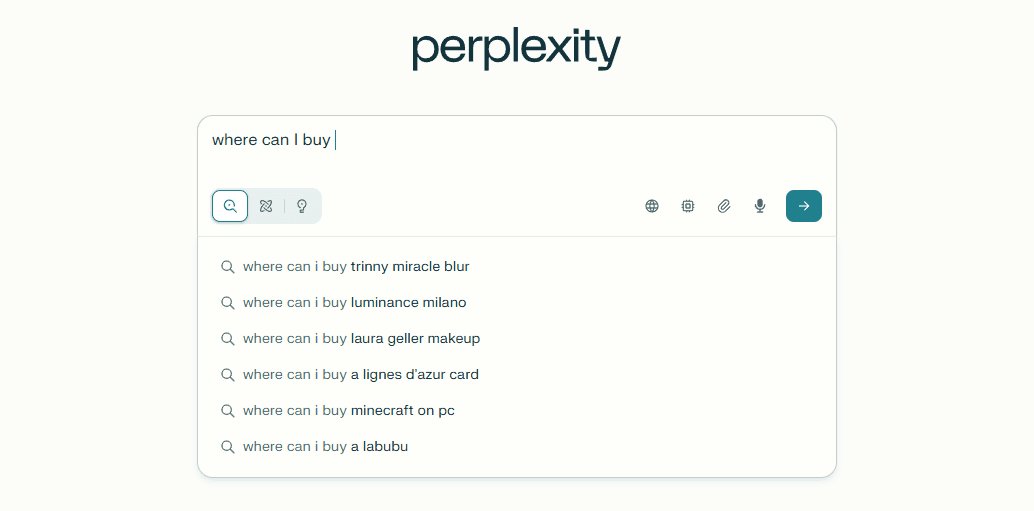
I’ve built this playbook to help you rank on Perplexity, based on real-world testing, AI-visibility tracking, prompt-level analysis, and behavior patterns observed across thousands of Perplexity answers.
How Perplexity Ranking Works (Key Signals AI Search Engines Look For)
Perplexity doesn’t rank pages like Google. It evaluates clarity, authority, trust, and extractability — and it prioritizes sources that consistently deliver useful, factual answers. From what I’ve observed tracking our own visibility at AIclicks.io, these are the core ranking signals:
Semantic clarity: Clean, answer-first writing that directly solves the query.
Topical authority: Interlinked clusters showing depth, not isolated one-off posts.
Factual accuracy: Verifiable data, credible sources, and up-to-date references.
Technical accessibility: Bing indexing, IndexNow updates, and server-side HTML.
This combination determines whether Perplexity lifts your content into an answer — or ignores it entirely.
How to Rank on Perplexity AI Search: Actionable Steps
Measure your AI visibility consistently: track Perplexity traffic (GA4 regex), monitor prompt-level mentions, and review citation patterns using AIclicks.io (or any other best Per .
Use answer-first, extractable content structure: short paragraphs, clean HTML, Q&A headings, bullets, tables, and one idea per section.
Build and maintain topical authority: create interconnected clusters, strengthen internal links, launch new posts monthly, and refresh outdated content.
Optimize technical accessibility: ensure Bing indexing, use IndexNow for updates, avoid JS-only content, and keep all important pages SSR/static.
Strengthen trust and external signals: maintain updated listings, earn citations from trusted domains, track which sources Perplexity references, and respond quickly to visibility drops.
Measuring and Monitoring Your Perplexity AI Search Behaviors
Perplexity AI visibility starts with measurement. Without real data, you’re guessing. At AIclicks, I’ve spent hours tracking how, where, and when our brand appears in Perplexity answers.
My advice: combine a dedicated AI visibility dashboard with prompt-level tracking and traditional analytics.
Set Up Source Tracking: Use GA4 with a living regex list of AI referrers (including Perplexity). Segment this traffic, validate landing pages, and watch conversions (learn more in our guide on tracking AI traffic in GA4).

Monitor AI-Generated Mentions: AIclicks.io centralizes prompt audits and brand mentions. You see exactly how often Perplexity recommends your content, and which URLs get cited. This lets you match prompts to revenue clusters, not just single pages.
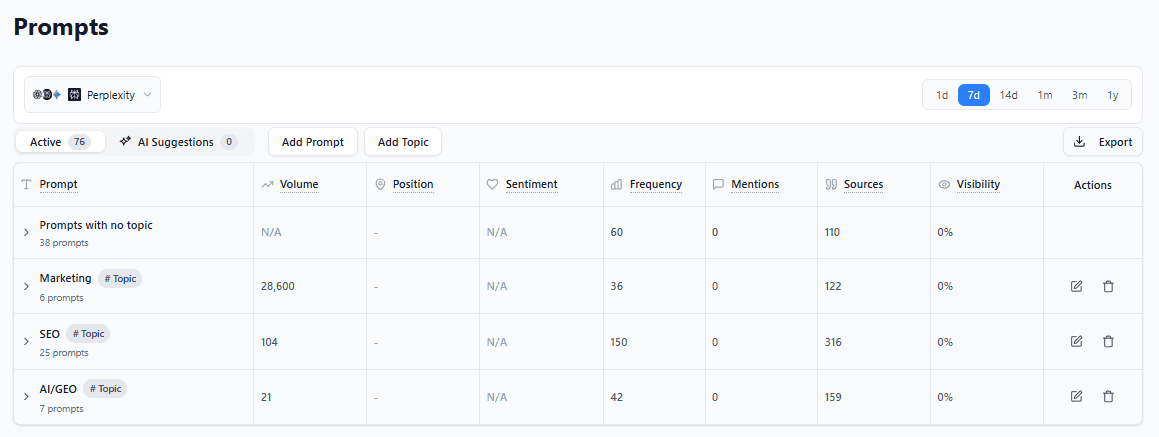
Map Clusters to ROI: Build sheets mapping prompt clusters (e.g., “best CRM for mid-market”) to supporting pages, their AI-cited positions, and external sources you need to win. This level of organization beats random optimizations.
Semantic Content Structure & Writing for AI Extraction
I’ve learned that Perplexity doesn’t care about lengthy prose or clever wordplay. It cares about clarity – answers delivered instantly.
Write answer-first intros. Use two or three sentences to solve the user’s query up front.
Organize by Q&A headings and keep paragraphs short (40-60 words). Break up complex information with bullet points and tables whenever possible.
For lists like “best X” queries, place your answers high on the page. The higher the snippet, the more likely Perplexity is to lift and cite your content(source).
Make content easy for AI driven search engines to extract: One core idea per section, clean headings (H2/H3), and keep all critical blocks in HTML, not JS-only shells.
Topical Authority and Clustering for Perplexity
Having a single great article won’t get you far. Perplexity’s ranking system rewards deep, interconnected expertise within a niche.
Build topic clusters. Create pillar pages for big ideas (“AI SEO for SaaS companies”) and link them to deep dives, collection posts, and thorough FAQs.
Use prompt analysis to guide your cluster building (see our guide on which prompts to track on ChatGPT and Perplexity for detailed insights). At AIclicks, I run weekly audits to see which topics have low penetration, then create supporting posts or comparison tables to strengthen our content “family.”

Interlink generously. Internal links from informational guides funnel authority to money pages – those landing pages built to convert and cite.
Content Freshness and Engagement
One lesson stands out: old, outdated, or low-engagement content rapidly loses visibility in Perplexity. Their reranker system loves fresh info.
Schedule regular content audits. We update stats, add examples, tweak intros, and refresh answers in FAQs.
Launch new posts monthly for every priority cluster, plus two to four supportive pages.
Watch for decay: If you see a drop in your prompt-level visibility, prioritize those fixes – rewrite intros, add a new table, or update key data.
Engagement matters. Perplexity AI rewards high user interaction and up-to-date references, dropping older results from top answers (source).
Indexing and Technical Accessibility
If Perplexity can’t find or index your pages, nothing else matters. Their crawler pipeline relies heavily on Bing’s search index and the IndexNow protocol – a detail often missed.
Verify your site in Bing Webmaster Tools. Submit segmented XML sitemaps covering products, collections, and blog posts.
Use IndexNow to push critical pages on every update – this gets new or refreshed content discovered fast.
Prefer server-side rendering (SSR) or static HTML for all important content. Avoid client-only frameworks for your main content, or you’ll risk invisibility.
Monitor for orphan pages and keep everything within three clicks from your homepage. This keeps crawlability high.
Building Trust, Authority, and External Validation
Perplexity trusts sources that others trust. External signals matter nearly as much as your own content.
Maintain fresh, accurate profiles on review sites (G2, Trustpilot, niche directories). I make it a weekly habit to update our listings and request placement refreshes in “best of X” roundups.
Get cited in listicles, guest posts, and forums (especially Reddit and vertical communities). Provide real utility – avoid link-spamming.
Track which external domains Perplexity currently references and monitor your citation share. At AIclicks, we shape our outreach based on which sources get cited most often.
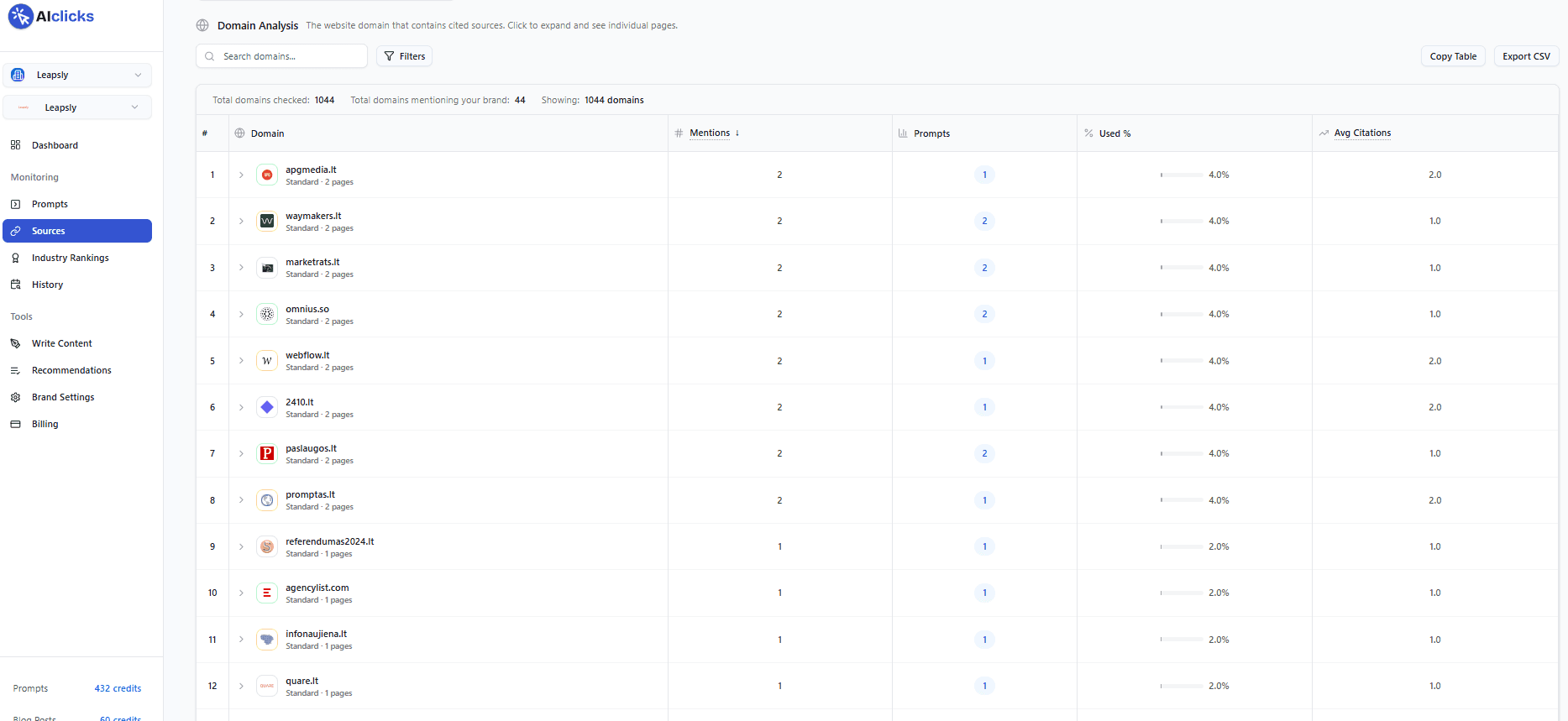
Proactive AI Search Engine Optimization and Content Governance
A “set and forget” approach fails in AI search. You need a living workflow with ongoing iteration and strict guardrails.
Weekly: Scan dashboards for prompt/brand positions. Ship micro-fixes – tighten intros, add comparison tables, improve headings. Outreach to directories, refresh listicles, and engage in active forum threads.
Monthly: Publish new cluster pillars, supportive guides, and re-audit technical coverage. Update your top external targets based on observed Perplexity citations.
Quarterly: Review AI-driven traffic, conversion rates, and which sources/structures get cited most. Templatize those wins for future use.
Guard your site: Check robots policies, review WAF logs, and hit Core Web Vitals. Add schema markup only when it genuinely clarifies content.
AI Tools for Perplexity SEO Success
Let me be clear – having the right tools is essential. Here’s what I use every day:
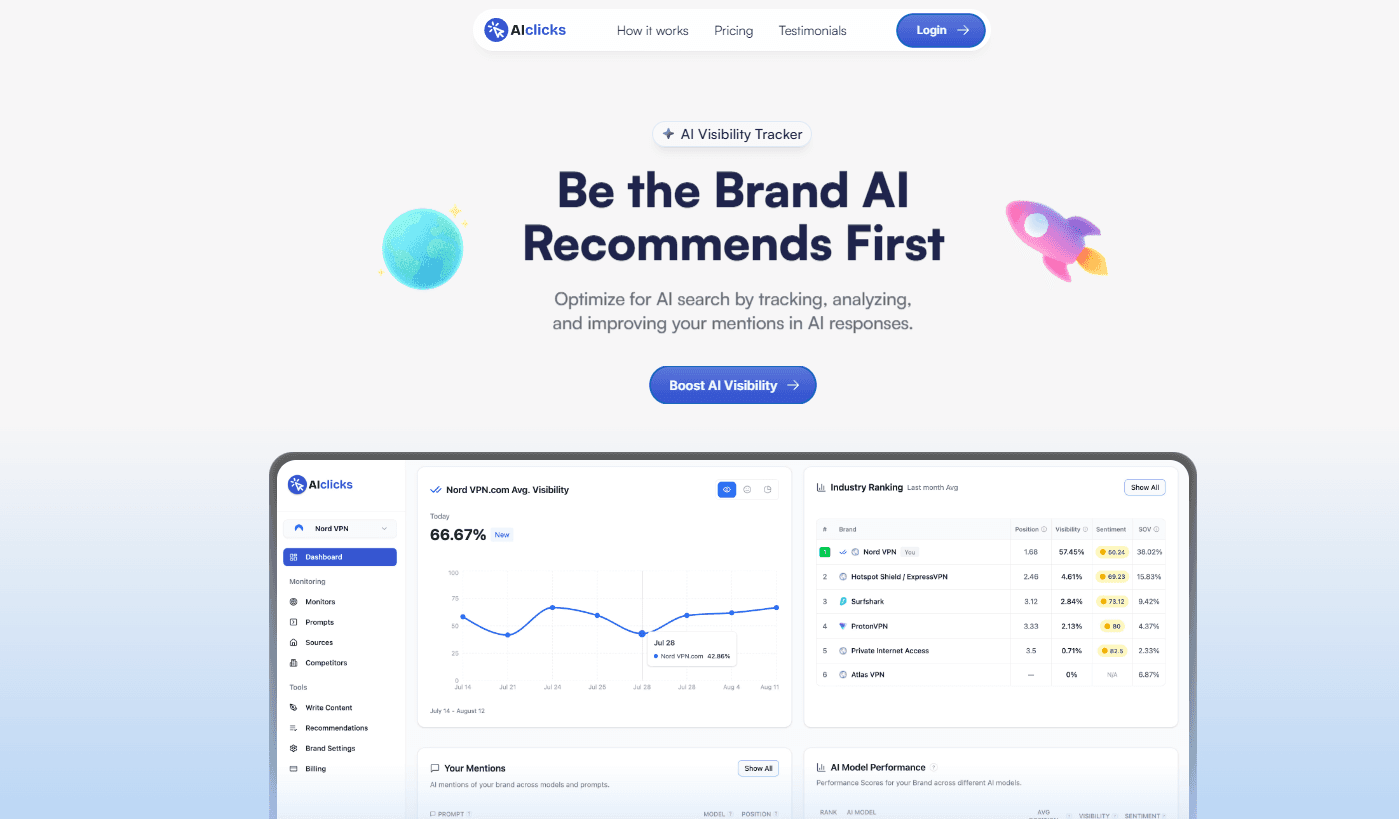
AIclicks.io (my platform): Tracks prompt-level visibility, dashboard analytics, citation intelligence, and recommends content improvements based on observed gaps. It’s how I audit our Perplexity presence, map clusters to ROI, and generate “AI-ready” content for semantic extraction.
Bing Webmaster Tools: Verifies indexing, crawls stats, and surfaces technical issues.
IndexNow: Pushes instant update notifications to Bing’s index for rapid visibility.
GA4 with regex for AI referrer traffic: Segments visitors coming from Perplexity and other AI surfaces.
External validation trackers: Monitor which domains are cited in Perplexity answers, guide guest posting and outreach.
If you want a deeper breakdown of these tools — including feature comparisons, strengths, and real test results — check out our full guide: best Perplexity rank tracking tools 2025.
Conclusion
Success in Perplexity AI search is no accident. It’s the result of structured, data-driven effort and constant refinement. Set up audits, track your brands and clusters, and make small weekly improvements. Use AI tools like AIclicks.io to uncover your true AI presence, identify and close gaps, and generate AI-optimized content at scale.
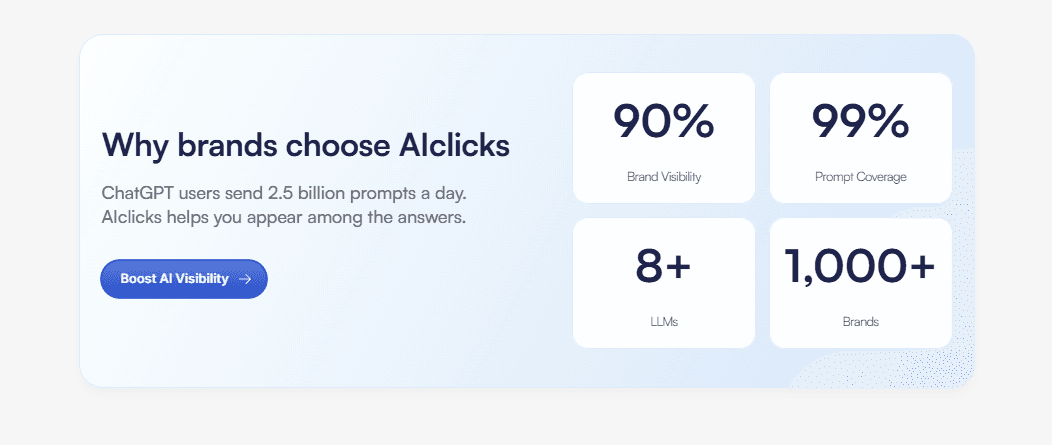
The next step? Audit your current Perplexity visibility. Start a dedicated workflow for AI search optimization. Stay proactive, keep learning, and adapt – AI search engines reward those willing to move fast and improve often.
Frequently Asked Questions (FAQ)
How to see mentions in Perplexity?
You can see brand or URL mentions in Perplexity by using an AI visibility platform like AIclicks.io, which tracks when Perplexity cites your pages, surfaces your prompts, and shows where your content appears in AI-generated answers. Perplexity itself does not offer a native “mentions” dashboard, so external tracking tools are required.
How to track keyword rankings on Perplexity?
Keyword rankings on Perplexity are tracked through AI search visibility tools that monitor share of answer, citation frequency, and where your content appears inside AI-generated responses. Instead of classic SERP positions, you track visibility across prompts, topics, and citations. Tools like AIclicks.io map prompts to URLs, clusters, and visibility trends over time.
How can I track sources mentioned by Perplexity?
Use external validation and citation tracking tools (including AIclicks.io) that scan Perplexity answers to identify which domains it references most often. These tools highlight the sources Perplexity trusts, how often competitors are cited, and where you should focus your outreach or authority-building. Perplexity does not publish its source list, so third-party monitoring is essential.
How to use Perplexity for SEO (search engine optimization)?
To use Perplexity for SEO, you should conduct keyword research to find questions and long-tail terms, create content structured with clear headings and Q&A format, and build backlinks to your site from authoritative sources that Perplexity can reference. Focus on producing high-quality, original content that is fresh and relevant to user intent, as this helps Perplexity index and cite your work as a source. Practice ongoing SEO monitoring and don't forget traditional SEO practices as they help AI driven search engines to form the answers.
How to get indexed by Perplexity answer engines?
Get your site indexed by using Perplexity AI Pro, submitting valuable pages, optimizing for AI search, and continually monitoring results. Make sure the technical foundation is sound, and never block Bing or AI search bots.
How to maximize Perplexity AI?
Leverage Focus Modes for specialized research, use file uploads for direct insight extraction, organize information with Pages and Spaces, and ask clear, detailed prompts for better answers. Make the most of multimedia integration and build your brand’s expertise by being cited in diverse contexts.
How to rank on AI results?
Provide direct, concise answers structured for extraction, build topical authority with unique, readable content, use semantic keywords and schema markup, maintain technical excellence, and regularly update content. Build brand visibility through authoritative backlinks, local citations, and public relations.
Our Content:
Tools
Best Claude SEO Tracking Tools for 2025
Nov 28, 2025
Tools
Best LLM SEO Analysis Tools in 2025
Nov 28, 2025
Tools
Best AI Overview Rank Trackers 2025
Nov 28, 2025
Tools
Best Grok Tracking Tools of 2025
Nov 28, 2025
Tools
Best Copilot Rank Tracking Tools 2025
Nov 28, 2025
Tools
10 Best AEO Tracking Tools in 2025
Nov 28, 2025
Any questions left?
Book a call here:











